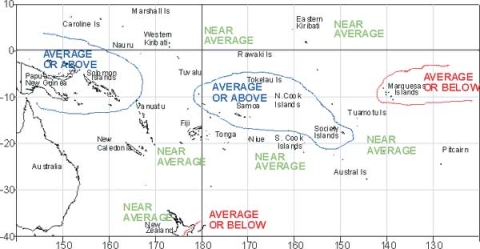Rainfall outlook for June to August 2003
Average or above average rainfall is expected from Papua New Guinea to the Solomon Islands, also from Wallis and Futuna to the Society Islands
Average or below average rainfall in the Marquesas Islands
Based on the recent climatic transitions in the equatorial Pacific, rainfall is expected to be average or above average from Papua New Guinea to the Solomon Islands, and also from Wallis and Futuna across to the Northern Cook Islands and Society Islands, including Samoa and Tokelau.
Average or below average rainfall is likely in the Marquesas Islands.
Near average rainfall is expected elsewhere in the Pacific over the upcoming three months.
Coupled with the sudden change in oceanic conditions in the equatorial Pacific and SOI, the rainfall forecast model skills are generally moderate to low for all countries in the region.
Rainfall outlook map for June to August 2003

Tropical Cyclones
‘GINA’, the 10th tropical cyclone this season was active at the time of writing. Gina originated at 10°S 170°E east of the Solomon Islands, taking a southwest track, with sustained maximum wind speeds of 100 km/h, gusts to 130 km/h at 13°S 168°E, and a central pressure of 985 hPa. It is unusual to have a tropical cyclone occurrence in June.
Tropical Cyclone ‘EPI’ formed east of Fiji, but decayed to a depression quickly.
At the time of publication of this newsletter not much information was available about the movement and intensity of these tropical cyclones.
Probabilities of rainfall departures from average
Broad-scale rainfall patterns and anomalies in the southern tropical Pacific area are estimated from the state of large-scale regional climate factors, such as La Niña or El Niño, their effect on the South Pacific and Tropical Convergence Zones, surface and sub-surface sea temperatures, and computer models of the global climate.
Rainfall estimates for the next three months for Pacific Islands are given in the adjacent table. The tercile probabilities (e.g. 20:30:50) are derived from the interpretation of several global climate models. They correspond to the odds of the observed rainfall being in the lowest (driest) one third of the rainfall distribution, the middle one third, or the highest (wettest) one third of the distribution. On the long-term average, rainfall is equally likely (33% chance) in any tercile.
The probabilities shown express the expected shift in the distribution from the long-term average, based on predictions of oceanic and atmospheric conditions. The amount of inter-model forecast consistency is indicated by the levels of confidence expressed in the table.
| Island Group | Rainfall Outlook | Confidence in the Outlook | |
|---|---|---|---|
| Papua New Guinea | 10:50:40 | (Average or above average) | Moderate |
| Solomon Islands | 10:45:45 | (Average or above average) | Moderate |
| Wallis and Futuna | 20:40:40 | (Average or above average) | Moderate |
| Tokelau | 20:40:40 | (Average or above average) | Moderate |
| Samoa | 15:45:40 | (Average or above average) | Moderate |
| Northern Cook Islands | 15:40:45 | (Average or above average) | Moderate |
| Society Islands | 15:40:45 | (Average or above average) | Moderate |
| Western Kiribati | 25:50:25 | (Near average) | Moderate |
| Eastern Kiribati | 25:50:25 | (Near average) | Moderate |
| Vanuatu | 20:50:30 | (Near average) | Moderate |
| Tuvalu | 30:45:25 | (Near average) | Moderate – Low |
| New Caledonia | 30:40:30 | (Near average) | Low |
| Fiji | 30:40:30 | (Near average) | Low |
| Tonga | 30:40:30 | (Near average) | Low |
| Niue | 30:40:30 | (Near average) | Low |
| Southern Cook Islands | 20:50:30 | (Near average) | Moderate |
| Pitcairn Island | 25:50:25 | (Near average) | Moderate |
| Austral Islands | 35:40:25 | (Near average) | Moderate |
| Tuamotu Islands | 20:50:30 | (Near average) | Moderate |
| Marquesas Islands | 35:40:25 | (Average or below average) | Moderate – Low |
Rainfall outcomes as estimated from models and historical records. The third column indicates the probability of bottom (below), middle (average) or top (above) tercile rainfall, where a percentage is given. The rainfall outlook (second column) is subjectively estimated from the probabilities of bottom, middle and top terciles.
